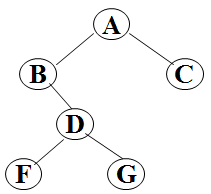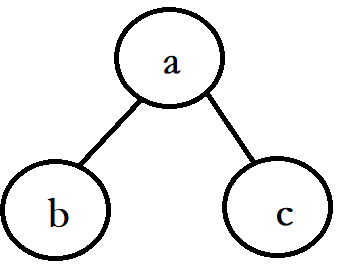程序填空题
5-1链栈入栈出栈操作。#include<iostream>using namespace std;typedef char SElemType;typedef struct StackNode {SElemType data;struct StackNode *next;} StackNode, *LinkStack;int Push(LinkStack &S, SElemT
5-1
链栈入栈出栈操作。
#include<iostream>
using namespace std;
typedef char SElemType;
typedef struct StackNode {
SElemType data;
struct StackNode *next;
} StackNode, *LinkStack;
int Push(LinkStack &S, SElemType e) {
LinkStack p;
p = new StackNode;
p->data = e;
delete p;
return 1;
}
int main() {
LinkStack s=NULL;
int n, i;
char c;
cin >> n;
for(i=0;i<n;i++){
cin >> c;
Push(s,c);
}
for(i=0;i<n;i++){
Pop(s,c);
cout << c << " ";
}
return 0;
}作者
王东
单位
贵州师范学院
时间限制
400 ms
内存限制
64 MB
5-2
本题目要求入顺序栈。
#define MAXSIZE 1024
#include <stdio.h>
#include <malloc.h>
typedef int datatype;
typedef struct
{
datatype data[MAXSIZE];
int top;
}SeqStack;
int Push_SeqStack (SeqStack *s, datatype x)
{ if (s->top==MAXSIZE-1) return 0;
else
{
return 1;
}
}作者
朱晓龙
单位
西安邮电大学
时间限制
400 ms
内存限制
64 MB
5-3
本题目要求出顺序栈。
#define MAXSIZE 1024
#include <stdio.h>
#include <malloc.h>
typedef int datatype;
typedef struct
{
datatype data[MAXSIZE];
int top;
}SeqStack;
int Pop_SeqStack(SeqStack *s, datatype *x)
{
if (Empty_SeqStack ( s ) ) return 0;
else
{
3分
=s->data[s->top];
3分
; return 1; } }
作者
朱晓龙
单位
西安邮电大学
时间限制
400 ms
内存限制
64 MB
5-4
本题目要求函数LinkStack Init_LinkStack () 初始化栈,并使用函数Empty_LinkStack (LinkStack top )判断链栈是否为空。链栈为空,函数返回1,否则返回0。
#include <stdio.h>
#include <malloc.h>
typedef int datatype;
typedef struct node
{ datatype data;
struct node *next;
}StackNode, * LinkStack;
LinkStack Init_LinkStack ()
{
return NULL;
}
int Empty_LinkStack (LinkStack top )
{
if (3分
) return 1; else return 0; }
作者
朱晓龙
单位
西安邮电大学
时间限制
400 ms
内存限制
64 MB
5-5
本题目要求实现压入链栈操作和弹出链栈操作。
#include <stdio.h>
#include <malloc.h>
typedef int datatype;
typedef struct node
{ datatype data;
struct node *next;
}StackNode, * LinkStack;
LinkStack Push_LinkStack (LinkStack top, datatype x)
{
StackNode *s;
s=(StackNode *)malloc (sizeof (StackNode));
s->data=x;
3分
;
3分
; return top; } LinkStack Pop_LinkStack (LinkStack top, datatype *x) { StackNode *p; if (top==NULL) return NULL; else {
3分
; p = top;
3分
; free (p); return top; } }
作者
朱晓龙
单位
西安邮电大学
时间限制
400 ms
内存限制
64 MB
5-6
本题目要求Init_SeQueue()函数初始化循环队列,返回指向队列的指针,Empty_SeQueue(c_SeQueue *q)函数判空队列,空队列返回1。否则返回0。
#include <stdio.h>
#include <malloc.h>
#define MAXSIZE 1024
typedef int datatype;
typedef struct {
datatype data[MAXSIZE]; /*数据的存储区*/
int front,rear; /*队头队尾指针*/
int num; /*队中元素的个数*/
}c_SeQueue; /*循环队*/
c_SeQueue* Init_SeQueue()
{
c_SeQueue *q;
q=(c_SeQueue*)malloc(sizeof(c_SeQueue));
3分
; q->num=0; return q; } int Empty_SeQueue(c_SeQueue *q) { if (
3分
) return 1; else return 0; }
作者
朱晓龙
单位
西安邮电大学
时间限制
400 ms
内存限制
64 MB
5-7
本题目要求Out_SeQueue (c_SeQueue *q , datatype *x)函数将 出循环队列的值送给变量x。出队成功返回1,否则返回-1。
#include <stdio.h>
#include <malloc.h>
#define MAXSIZE 1024
typedef int datatype;
typedef struct {
datatype data[MAXSIZE]; /*数据的存储区*/
int front,rear; /*队头队尾指针*/
int num; /*队中元素的个数*/
}c_SeQueue; /*循环队*/
int Out_SeQueue (c_SeQueue *q , datatype *x)
{
if (q->num==0)
{
printf("The c+SeQueue is empty");
return -1;
}
else
{
q->front=3分
; *x=q->data[q->front];
3分
; return 1; } }
作者
朱晓龙
单位
西安邮电大学
时间限制
400 ms
内存限制
64 MB
5-8
本题目要求Init_LQueue()函数初始化带头结点的链队列,并用Empty_LQueue( LQueue *q)函数判断队列是否为空,队列为空返回1,否则返回0。
#include <stdio.h>
#include <malloc.h>
typedef int datatype;
typedef struct node
{
datatype data;
struct node *next;
}QNode;
typedef struct
{
QNode *front, *rear;
}LQueue;
LQueue *Init_LQueue()
{
LQueue *q;
QNode *p;
q=(LQueue * )malloc(sizeof(LQueue));
p=(QNode * )malloc(sizeof(QNode));
p->next=NULL;
3分
; return q; } int Empty_LQueue( LQueue *q) { if (
3分
) return 1; else return 0; }
作者
朱晓龙
单位
西安邮电大学
时间限制
400 ms
内存限制
64 MB
5-9
本题目要求使用函数In_LQueue(LQueue *q , datatype x)将数据x入链队列q中。
#include <stdio.h>
#include <malloc.h>
typedef int datatype;
typedef struct node
{
datatype data;
struct node *next;
}QNode;
typedef struct
{
QNode *front, *rear;
}LQueue;
void In_LQueue(LQueue *q , datatype x)
{
QNode *p;
p=(QNode * )malloc(sizeof(QNode));
p->data=x;
p->next=NULL;
3分
;
3分
; }
作者
朱晓龙
单位
西安邮电大学
时间限制
400 ms
内存限制
64 MB
5-10
本题目要求使用函数Out_LQueue(LQueue *q , datatype *x)从链队列q中弹出数据。
#include <stdio.h>
#include <malloc.h>
typedef int datatype;
typedef struct node
{
datatype data;
struct node *next;
}QNode;
typedef struct
{
QNode *front, *rear;
}LQueue;
int Out_LQueue(LQueue *q , datatype *x)
{
QNode *p;
if (Empty_LQueue(q) )
{
printf ("The LQueue is empty");
return 0;
}
else
{
p=q->front->next;
3分
; *x=p->data; free(p); if (q->front->next==NULL)
3分
; return 1; } }
作者
朱晓龙
单位
西安邮电大学
时间限制
400 ms
内存限制
64 MB
5-11
下列代码的功能是将二叉树T中的结点按照层序遍历的顺序输出。
typedef struct TreeNode *Tree;
struct TreeNode
{
int Key;
Tree Left;
Tree Right;
};
void Level_order ( Tree T )
{
Queue Q;
if ( !T ) return;
Q = CreateQueue( MaxElements );
Enqueue( T, Q );
while ( !IsEmpty( Q ) ){
T = Front_Dequeue ( Q ); /* return the front element and delete it from Q */
printf("%d ", T->Key);
if ( T->Left )
3分
; if (
3分
)
3分
; } }
作者
陈越
单位
浙江大学
时间限制
400 ms
内存限制
64 MB
5-12
下列代码的功能是计算给定二叉树T的宽度。二叉树的宽度是指各层结点数的最大值。函数Queue_rear和Queue_front分别返回当前队列Q中队尾和队首元素的位置。
typedef struct TreeNode *BinTree;
struct TreeNode
{
int Key;
BinTree Left;
BinTree Right;
};
int Width( BinTree T )
{
BinTree p;
Queue Q;
int Last, temp_width, max_width;
temp_width = max_width = 0;
Q = CreateQueue(MaxElements);
Last = Queue_rear(Q);
if ( T == NULL) return 0;
else {
Enqueue(T, Q);
while (!IsEmpty(Q)) {
p = Front_Dequeue(Q);
3分
; if ( p->Left != NULL ) Enqueue(p->Left, Q);
3分
; if ( Queue_front(Q) > Last ) { Last = Queue_rear(Q); if ( temp_width > max_width ) max_width = temp_width;
3分
; } /* end-if */ } /* end-while */ return max_width; } /* end-else */ }
作者
陈越
单位
浙江大学
时间限制
400 ms
内存限制
64 MB
5-13
二叉树的层序遍历: 下面代码的功能是将二叉树中的结点按层次序遍历的顺序输出。请填空。
#include <stdio.h>
#include <stdlib.h>
#include <queue>
#include <stack>
using namespace std;
struct TreeNode
{
char data;
TreeNode* left;
TreeNode* right;
};
void levelOrder(struct TreeNode* root)
{
queue<struct TreeNode*> que;
if (root == NULL)return;
que.push(root);
while (!que.empty()) {
struct TreeNode* tmp = que.front();
que.pop();
printf(" %c", tmp->data);
if (tmp->left)
5分
; if (
5分
)
5分
; } }
作者
李廷元
单位
中国民用航空飞行学院
时间限制
400 ms
内存限制
64 MB
5-14
已知先序遍历序列和中序遍历序列建立二叉树。 例如

输入先序遍历序列: ABDFGC, 再输入中序遍历序列: BFDGAC,则 输出该二叉树的后序遍历序列: FGDBCA。
#include <stdio.h>
#include <stdlib.h>
#include <string.h>
typedef char ElementType;
typedef struct BiTNode{
ElementType data;
struct BiTNode *lchild;
struct BiTNode *rchild;
}BiTNode,*BiTree;
BiTree CreatBinTree(char *pre,char*in,int n );
void postorder( BiTree T );
int main()
{
BiTree T;
char prelist[100];
char inlist[100];
int length;
scanf("%s",prelist);
scanf("%s",inlist);
length=strlen(prelist);
T=CreatBinTree(prelist,inlist, length);
postorder( T );
return 0;
}
void postorder( BiTree T )
{
if(T)
{
postorder(T->lchild);
postorder(T->rchild);
printf("%c",T->data);
}
}
BiTree CreatBinTree(char *pre,char*in,int n)
{
BiTree T;
int i;
if(n<=0) return NULL;
T=(BiTree)malloc(sizeof(BiTNode));
T->data=pre[0];
for(i=0;in[i]!=pre[0];i++);
T->lchild=3分
; T->rchild=
3分
; return T; }
作者
DS课程组
单位
临沂大学
时间限制
400 ms
内存限制
64 MB
5-15
创建哈夫曼树。
#include<cstring>
#include<iostream>
using namespace std;
typedef struct
{
int weight;
int parent,lchild,rchild;
}HTNode,*HuffmanTree;
typedef char **HuffmanCode;
void Select(HuffmanTree HT,int len,int &s1,int &s2)
{
int i,min1=32767,min2=32767;
for(i=1;i<=len;i++)
{
if(HT[i].weight<min1&&HT[i].parent==0)
{
s2=s1;
min2=min1;
min1=HT[i].weight;
s1=i;
}
else if(HT[i].weight<min2&&HT[i].parent==0)
{ min2=HT[i].weight;
s2=i;
}
}
}
void CreatHuffmanTree(HuffmanTree &HT,int n)
{
int m,s1,s2,i;
if(n<=1) return;
m=2*n-1;
HT=new HTNode[m+1];
for(i=1;i<=m;++i)
{ HT[i].parent=0; HT[i].lchild=0; HT[i].rchild=0; }
for(i=1;i<=n;++i)
cin >> HT[i].weight;
for(i=n+1;i<=m;++i)
{
2分
; HT[s1].parent=
2分
; HT[s2].parent=
2分
; HT[i].lchild=
2分
; HT[i].rchild=
2分
; HT[i].weight=
2分
; } } void print(HuffmanTree HT,int n) { for(int i=1;i<=2*n-1;i++) cout << HT[i].weight << " " << HT[i].parent << " " << HT[i].lchild << " " << HT[i].rchild << endl; } int main() { HuffmanTree HT; int n; cin >> n; CreatHuffmanTree(HT,n); print(HT,n); return 0; }
输入样例:
第一行输入一个数n(1<n<100),表示叶子节点的个数,接下去输入n个整数(小于1000),表示每个节点表示的字符和权值。
5 1 5 2 7 10输出样例:
输出2*n-1行,每行输出哈夫曼节点的权值、父节点编号、左右孩子节点编号。
1 6 0 0
5 7 0 0
2 6 0 0
7 8 0 0
10 9 0 0
3 7 1 3
8 8 6 2
15 9 4 7
25 0 5 8作者
王东
单位
贵州师范学院
时间限制
400 ms
内存限制
64 MB
5-16
#include<iostream>
using namespace std;
typedef struct ElemType{
int key;
}ElemType;
typedef struct BSTNode{
ElemType data;
BSTNode *lchild,*rchild;
}BSTNode,*BSTree;
int flag=1;
BSTree SearchBST(BSTree T,char key) {
if(2分
) return T; else if (key<T->data.key)
2分
; else
2分
; } void InsertBST(BSTree &T,ElemType e );//实现细节隐藏 void CreateBST(BSTree &T ) { int i=1,n; cin >> n; T=NULL; ElemType e; while(i<=n){ cin>>e.key; InsertBST(T, e); i++; } } int main() { BSTree T; CreateBST(T); int key; cin>>key; BSTree result=SearchBST(T,key); if(result) {cout<<"find!";} else {cout<<"not find!";} return 0; }
作者
王东
单位
贵州师范学院
时间限制
400 ms
内存限制
64 MB
5-17
使用递归方式计算二叉树的深度。提示:二叉树是根据先序遍历顺序建立起来的。
#include<stdio.h>
#include<stdlib.h>
typedef struct BiNode
{
char data;
struct BiNode *lchild, *rchild;
}BiTNode, *BiTree;
void CreateBiTree(BiTree * T)
{
char ch;
scanf("%c", &ch);
if (ch == '#')
*T = NULL;
else
{
*T = (BiTree)malloc(sizeof(BiTNode));
(*T)->data = ch;
CreateBiTree(&(*T)->lchild);
CreateBiTree(&(*T)->rchild);
}
}
int Depth(BiTree T)
{
int m, n;
if (2分
) return 0; else { m =
2分
; n =
2分
; if (m > n) return(m + 1); else return (n + 1); } } int main() { BiTree tree = NULL; CreateBiTree(&tree); int depth = Depth(tree); printf("%d", depth); return 0; }
测试数据

输入:ab##c##
输出:2
作者
余雨萍
单位
中原工学院
时间限制
400 ms
内存限制
64 MB
5-18
给定一组整数:
{ 47, 25, 87, 36, 90, 18, 65, 31, 79, 58 }采用简单选择排序法,请写出经过一趟排序后的结果:
{ 4分
}
注:请使用西文半角逗号。
作者
李祥
单位
湖北经济学院
时间限制
400 ms
内存限制
64 MB
5-19
给定一组整数:
{ 47, 25, 87, 36, 90, 18, 65, 31, 79, 58 }采用直接插入排序法,请写出经过一趟排序后的结果:
{ 4分
}
注:请使用西文半角逗号。
作者
李祥
单位
湖北经济学院
时间限制
400 ms
内存限制
64 MB
5-20
本题要求实现快速排序操作,待排序列的长度1<=n<=1000。 使排序后的数据从小到大排列。 ###类型定义:
typedef int KeyType;
typedef struct {
KeyType *elem; /*elem[0]一般作哨兵或缓冲区*/
int Length;
}SqList;程序:
#include<stdio.h>
#include<stdlib.h>
typedef int KeyType;
typedef struct {
KeyType *elem; /*elem[0]一般作哨兵或缓冲区*/
int Length;
}SqList;
void CreatSqList(SqList *L);/*待排序列建立,由裁判实现,细节不表*/
int Partition ( SqList L,int low, int high );
void Qsort ( SqList L,int low, int high );
int main()
{
SqList L;
int i;
CreatSqList(&L);
Qsort(L,1,L.Length);
for(i=1;i<=L.Length;i++)
{
printf("%d ",L.elem[i]);
}
return 0;
}
int Partition ( SqList L,int low, int high )
{ /*一趟划分*/
KeyType pivotkey;
L.elem[0] = L.elem[low];
pivotkey = L.elem[low];
while(low<high)
{
while ( low < high && L.elem[high] >= pivotkey )
--high;
L.elem[low] = L.elem[high];
while ( low < high && L.elem[low] <= pivotkey )
++low;
L.elem[high] = L.elem[low];
}
L.elem[low]=L.elem[0];
return low;
}
void Qsort ( SqList L,int low, int high )
{
int pivotloc;
if (2分
) { pivotloc = Partition(L, low, high ) ; Qsort (
1分
) ;
1分
; } }
输入样例:
第一行整数表示参与排序的关键字个数。第二行是关键字值 例如:
10
5 2 4 1 8 9 10 12 3 6输出样例:
输出由小到大的有序序列,每一个关键字之间由空格隔开,最后一个关键字后有一个空格。
1 2 3 4 5 6 8 9 10 12 作者
DS课程组
单位
临沂大学
时间限制
400 ms
内存限制
64 MB
5-21
冒泡排序
给定一组整数:
{ 47, 25, 87, 36, 90, 18, 65, 31, 79, 58 }采用冒泡排序法,请写出经过一趟排序后的结果:
{ 4分
}
注:请使用西文半角逗号。
更多推荐
 已为社区贡献2条内容
已为社区贡献2条内容








所有评论(0)